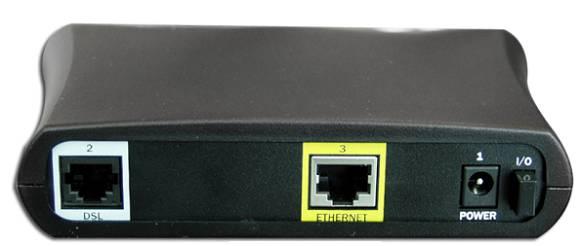DSL Network Guide Chapter 8: DSL Modems


Every DSL modem is different. This one pictured above is the Efficient Networks Speedstream 5100. It gives us a good overview of what you might find on most modems.
All modems should have a power light. This light simply lets us know that the modem has power. On most modems the power light can be a different color like red or orange. This usually indicates the modem failed during the POST process (read below for more on POST.)
Modems will also have a synch light. This is usually labeled DSL. When this light is green that means the modem can detect a DSL signal on the telephone lines. Colors other than green usually indicate the modem was unable to find a DSL signal on the phone line.
Your modem should also have a LAN light. This light is usually labeled Enternet, LAN, 10, or 100. This light should go solid green if the CAT5 cable is plugged into a proper device (i.e. your computer or router) and that device is responding properly.
The activity light let's you know that there is traffic on your network. This traffic could be traveling to or from your modem, either to your computer or to the internet. Usually to indicate traffic the light will blink green.
If you have any question as to the meaning of a light on your modem contact either your ISP or the manufacturer of that modem. Some modems have additional lights, or the lights are labeled in ways that are hard to guess. Also what the different colored lights mean can be hard to figure. Your ISP or modem manufacturer should have this information as well.
Most modems have only three plugs on the back of them, a phone jack, a CAT5 jack, and a power plug-in. The telephone cable should run from the modem to your wall jack. The CAT5 cable should run from the modem to either your routers port or your computers NIC. The power cable should plug into a normal power jack.
When you turn on your modem it goes through what is called POST, power on self test. This is essentially the same thing like booting up a computer. The modem check all of it's components to ensure they are operating properly and loads the firmware into memory. During this time your lights will be going crazy. If post is unsuccesful it will usually give you some kind of indication like a red power light. If it passes then most modems will have a green power light and then all the other lights will go blank. Usually the modem will try to establish an ethernet connection to your computer or router. Once it has determine the status of the ethernet connection it will usually try to find a DSL signal on the DSL modem. If the ethernet and DSL signal are good you should now be able to connect.
One problem a lot of people experience with their modems is EMI, electro magnetic interference. EMI is essentialy what happens when you are watching TV and turn on your vacuum cleaner, or you are driving through a country town listening to your radio and a UFO flies by. These devices cause interference that give you popping and possibly even a total loss of signal. With the modem this can cause slow browsing or the need to power cycle frequently, or intermittent loss of synch. Some of the more common culprits of causing EMI are your computer, monitor, speakers, printers, scanners, flourescent lights, power strips, and other common electronic devices near your computer. If you suspect EMI issues move your modem as far away from these devices as possible, preferably about 4 or 5 feet.
If you experience issues like every night at 8pm you lose synch this could be caused by EMI. Determining these issues can be a real pain. You could be looking at a street light that turns on at the same time every night, someone blow dries their hair at the same time, a fan that is turned on right at your childs bed time, etc., etc. When it comes to determining exactly what it is causing these problems I wish you all the luck in the world.
<-Back Table of Contents Next->



